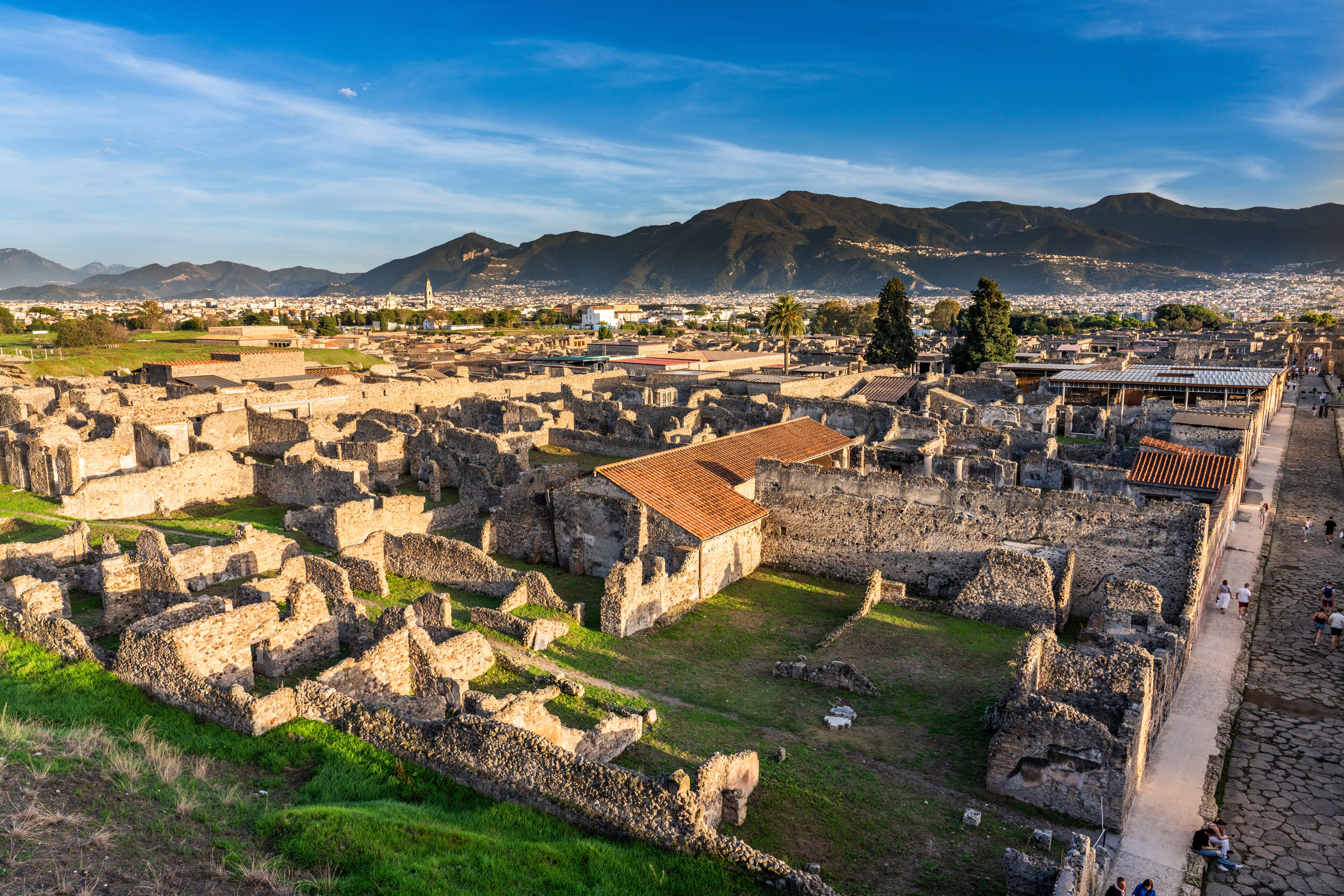Interesting Facts about Pompeii

-
Nobody knows the exact date of the eruption
The date of Pompeii's eruption is still unknown, adding to its mystery. Many experts believe the eruption occurred in the summer of 79 AD. However, the exact day remains uncertain, sparking speculation about the events preceding the disaster.
-
Mount Vesuvius was not considered a volcano
To ancient Pompeians, Mount Vesuvius was just a mountain. They didn't know it was a volcano. The word "volcano" didn’t exist before AD 79.
The term was coined after the devastating eruption, inspired by Vulcan, the Roman God of Flame. This event shocked residents and revealed the immense power of nature they faced daily.
-
Greek vs. Roman Origins
Pompeii wasn't always Roman! Even though it's famous as a Roman city, it started as a Greek town called "Pompe" around 700 BC. It wasn't until centuries later that the Romans conquered it and made it part of their empire.
The name Pompeii itself might have Oscan roots, not Greek. Historians think "Pompeii" might come from the Oscan word "pompe," meaning "five." This could mean the town formed from five settlements or was governed by a council of five.
-
Pompeii Bath Houses were not just for cleanliness
Ancient Romans valued communal bathing as both a hygiene practice and a social activity. Unlike showers today, bath time was a community event.
These bathhouses were massive, with all kinds of rooms – hot, and cold, pools, and places for massages and treatments. They were where the community gathered to wash up, work out, and hang out.
Sure, the main goal was cleanliness. They'd rub oil on their skin, scrape it off with a tool called a strigil, and then wash in the water. Soap wasn't a thing back then, so they relied on the oil and scraping to get clean.
But it was also a chance to catch up with friends, gossip, or play games. Men even talked about business and politics there. The bathhouses even had beautiful gardens, exercise rooms, and libraries, making them a true leisure spot.
It's no wonder these baths were such a hit across the ancient Roman world!
-
Amphitheatre In Pompeii
The Pompeii Amphitheatre stands out for its architectural features. It's structured with distinct sections allocated to different social classes, a notable aspect of its design.
There are three primary sections: the lower, middle, and upper parts. The lower central area was reserved for dignitaries, while the higher seats were for the general public.
One interesting thing is the velarium, a cover over the amphitheatre to shield it from rain or sun. Traces of the rings used to fasten the canopy can still be seen.
With its huge capacity, it attracted visitors from various regions, reflecting its significance as a prominent venue in Pompeii.
-
Pompeii Fresco Paintings
One of the most interesting things about Pompeii is its wall paintings. The ancient city is one of the few places on earth with Roman frescoes.
Before Pompeii was discovered, we knew very little about Roman painting. We only had rare and scattered fragments of frescoes. In Pompeii, frescoes were found in both public and private buildings.
These paintings have given us a better understanding of ancient Pompeian life. They reveal details about their daily routines, beliefs, and customs.
Based on studies and the classification by Vitruvius, the paintings are usually divided into four styles:
-
Incrustation or structural style
-
Architectural style
-
Egyptianizing style
-
Architectural illusionism or ornamental style
-
Bodies were Cast by Researchers
Researchers created casts of bodies found at the site. Decades after the eruption, archaeologists discovered empty spaces where bodies had been. Plaster was poured into these spaces to understand more about the victims. This resulted in eerie casts that depicted the final moments of people and animals affected by the disaster.
-
Multicultural Pompeii
Pompeii was a lively mix of cultures, blending Greek and Latin influences. Its trade links reached across Asia, making it a diverse hub.
Trade flourished, bringing goods and people from all over the Mediterranean. Picture the marketplace buzzing with spices, vibrant fabrics, and treasures from distant places. Scientists even discovered remains of people with Greek roots and possibly other backgrounds, highlighting Pompeii's rich diversity.
-
Gambling was Part of Regular life
In Pompeii, everyone gambled, making daily life more exciting. They played dice, and board games, and bet on chariot races for fun, enjoying breaks from work and socializing with others.
-
Unique Street Design
They had clever ways of designing streets to keep them clean and prevent muddy feet. The streets were designed with raised sidewalks and stepping stones to help people cross when it rained. This kept the main paths dry and clean, making it easier to walk around the city.
-
There is a lot of Graffiti
Pompeii's walls are filled with graffiti, showcasing various thoughts and concerns of its people. These inscriptions reveal political views, personal matters, and expressions of love, providing valuable insights into Pompeii's society.
-
The wind was simply blowing the wrong way:
The wind's direction was key during the eruption. Normally, it would have carried ash away from Pompeii. But that day, an unusual north-westerly wind blew the ash cloud right towards the city.
This twist of fate buried Pompeii for ages and caused immense loss of life, all because of a change in wind direction. It's a stark reminder of how even small things can make a huge impact.
-
People of Pompeii loved to go out to drink and eat
In Pompeii, Thermopolis and taverns buzzed with social life, where people bonded over food and drink. These spots served diverse dishes like lentil stew and fish, offering a glimpse into Pompeian culinary traditions and culture.